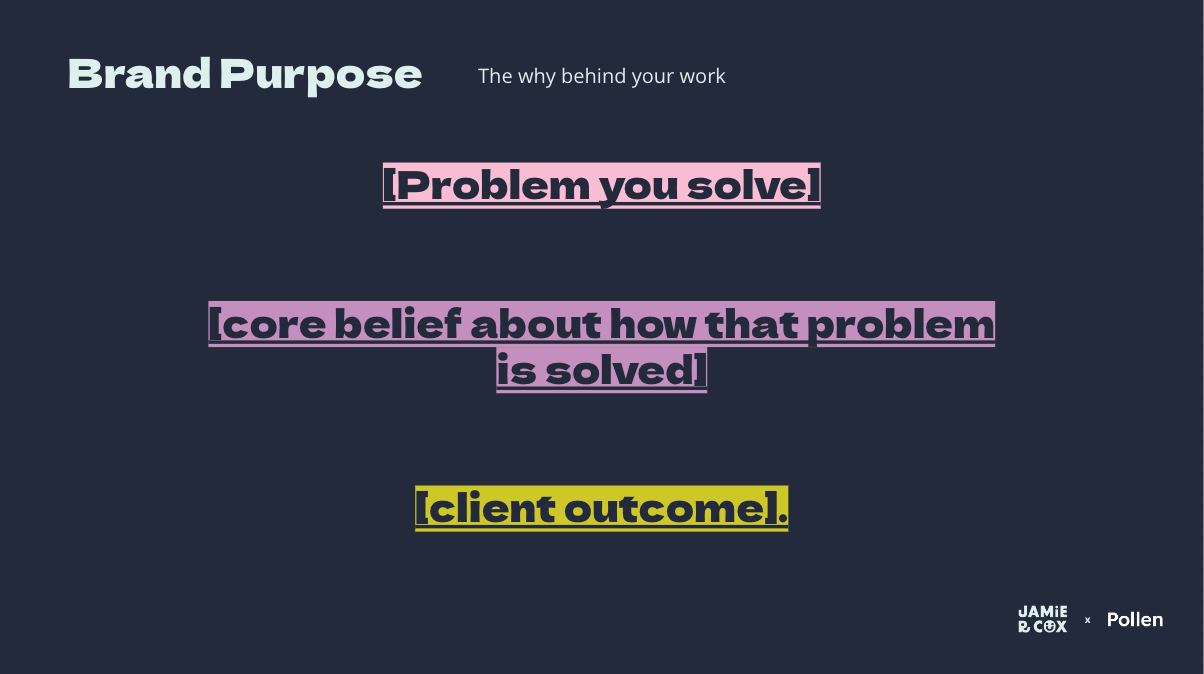Develop Brand Messaging Foundations
Answering, “What do I say about myself?” is a common challenge for small business owners and solopreneurs. You know who you are, what you do, and why you do it, but translating that into compelling messages that resonate with your target audience is difficult.
Effective brand messaging is key to connecting with and expanding your customer base. It captures attention, differentiates you from competitors, and builds trust and excitement. Consistent messaging also simplifies content creation across various platforms.
A brand messaging foundation makes your communication repeatable, consistent, and compelling. Start with the basics: your purpose, identity, activities, and unique value proposition. Clarity on these foundational elements will make it easier to craft marketing messages for different channels.
Two things to note:
- This messaging work may seem repetitive, but that’s okay. You’ll reuse copy throughout this exercise. Remember, you’re building blocks—trust the process!
- Initially, approach the messaging frameworks in a bare-bones style. Focus on precise answers, and we’ll add personality later.
If you’re familiar with Simon Sinek’s work, you might have heard him say, “People don’t buy what you do, they buy why you do it.” That “why” is your brand purpose.
The way I like to approach a brand purpose is by articulating the problem you solve, your beliefs about the solution, and the transformation you offer to clients.
To put it in a simple formula, it looks like:
The problem you solve + the core belief about how you solve it = client outcome
Here’s an example of my own brand messaging foundation from my own business as a brand strategist: My brand purpose is that building a better business begins with building a brand foundation that represents you and your values so you can foster more meaningful relationships with your customers.

Go ahead and fill in that same formula for yourself. Remember, keep it simple and focus on answering the prompts. We’ll incorporate personality later.
A good “Who you are” statement consists of two things: your title and how you see things differently.
Your title.Keep this simple. Many people get tripped up on their titles because they do more than one thing.
No matter if you offer one or many different services, you want to hone in on a title that your audience is actually looking for and you want to be known for.
How you see things differently. Lean into your differentiator and unique perspective. Go beyond plainly stating what you do and your qualifications and incorporate your beliefs and special approach to make this statement more powerful.
My “Who you are” statement is: Jamie R. Cox is a brand strategist who believes that brands are better when they represent the unique personality of the person behind the business.
This is definitely a differentiator for me. A lot of people think you have to fit into a box, whereas I think you should be able to be yourself in your business. And that's the unconventional approach I have to this work that makes me stand out.

Your unique value proposition ties back into the brand differentiators and positioning that you established in the positioning statement guide. So, if you’ve done that work, now is the time to reference it. If not, you can still move forward with this and come back to it if needed.
The formula I use for my unique value proposition is:
Client pain point + how the competitor misses the mark + how you do it differently
- Highlight their pain point: This will make your customers feel seen and heard, especially when you use the same wording they use when describing their pain points.
- How competitors miss the mark: You don’t need to go into detail with specific names, but speak to the industry and how they fall short.
- How you do it differently: Finally, in comparison to those competitors, what about you makes you better than the rest?
Tip: If you’re serving very different audiences with very different services, you may need more than one unique value proposition. But for most people, one will be enough.
Using that formula, here’s what my unique value proposition looks like: If you're struggling to reach the next level of your business, stop following trends that come and go and instead build a brand that's uniquely you, one that represents you and your values, so you can capture the attention of the customers that matter most.

Ah yes, everyone’s favorite question — kidding.
When someone asks you what you do in the real world, it can be difficult to answer. Like most people, you probably do a lot of things. If you stay too simple, it’s not memorable. If you get too clever, it’s hard to understand.
A good “What you do” statement goes beyond a job title. Rather than just saying, “I’m a brand strategist,” I like to approach it by going into a bit more detail, first by talking about how I do what I do.
The formula I like to use here is:
How you do what you do + what you offer + who you do it for = client outcome
- How you do what you do: What is your unique approach or process that makes you great
- What you offer: Similar to your title, keep it simple
- Who you do it for: This is your ideal customer
- Client outcome: The transformation they receive and, ultimately why they care
My “What you do” statement is: Through candid conversations and connection, Jamie offers brand strategy for solopreneurs and small business owners so they can foster better, more meaningful relationships with their customers.
As you can see, my client's outcome is coming up again and again. Remember, these are not going to appear side by side all over your website. These are building blocks. So, if it starts to feel repetitive, that’s okay. Just lean into the repetition and trust the process.

What clients receive
Your “What clients receive” statement should highlight how your unique processes create a transformation that clients really want and can only get from you. This will help them choose to work with you over somebody else.
The formula I like to use here is:
Your unique process + the value of that process = client transformation
- Your unique process: Build off the “how I do what I do” part of your “What you do” statement to showcase the special approach that differentiates you.
- The value of that process: This communicates what you get as a result of that process that produces a more desirable transformation.
- Client transformation: What the client ultimately cares about, going back to the client’s “why.”
By this point, the client transformation has been repeated multiple times. That’s good — that’s what they ultimately care about, so you want them to know you for the transformation they can get from you.
My “What clients receive” statement is: Through a personalized discovery process that prioritizes candid conversations, Jamie's clients discover their brand's personality and learn to showcase it so they can make more meaningful connections with their customers.

Now that you have all of your messaging foundations in place, it’s time to infuse them with some personality.
Here, you’re taking all the answers you compiled throughout this guide and thinking through how you want them to come across to your audience. If you want to go deeper into this work, take a look at the brand personality archetypes.
Some brand personalities will be more direct and to the point, some will be more illustrative, and some might evoke a lot of emotion. Small word tweaks can capture a lot of personality.
Here’s how my unique value proposition looks through the lens of a different archetypes. You’ll see some different language in each, but they’re all saying the same thing: “Transform your business, don’t follow trends.”
- Outlaw: Rebel against the allure of trends; build a brand that defies the norm.
- Magician: Transform your business by leaving behind passing trends.
- Hero: Conquer business challenges with a brand that outlives passing trends
- Lover: Develop meaningful and long-lasting customer relationships with a brand free of fleeting trends.
- Jester: Laugh in the face of passing trends and dance to the beat of your own brand.
- Everyman: Skip the flashy trends and build a brand that’s tried and true.
- Caregiver: Craft a brand that supports you and your business growth by sidestepping fleeting trends.
- Creator: Craft a brand masterpiece by tuning out trends and focusing on what makes you unique.
- Ruler: Take control of your business by building a brand that avoids trends.
- Innocent: Take the simple path to business growth by stepping away from transient trends.
- Sage: Elevate your brand by transcending the allure of passing trends.
- Explorer: Break free from fleeting fads and venture into uncharted territories of business growth.
independent consulting business to the next level.







